Once said to be the main internal security threat facing India, the decades-long Maoist insurgency now seems to be at a turning point. A major turning point in the Maoist insurgency reduction in India is the recent murder of prominent Maoist leader Nambala Keshava Rao, sometimes known as Basavaraju. This incident begs a significant issue: is the end of this protracted fight really within grasp, or is this only another stage in a multifarious and strong struggle?
- How have technological and social changes helped to explain India’s Maoist insurgency decline?
- Why Does Political Disconnect Speed the Maoist Insurgency Decline in India?
- Which are the primary security and development issues still unresolved in the areas under Maoist influence?
- How could political engagement and communication help to support the drop in Maoist insurgency in India?
- What promises does the Maoist Insurgency Decline in India hold going forward?
- Conclusion
What Has Driven India’s Maoist Insurgency Decline?
The Maoist insurgency began in West Bengal with the Naxalbari revolt in 1967. The campaign grew over decades to produce a sizable “red corridor,” running from Jharkhand in the east to Maharashtra in the west. Covering more than a third of India’s regions, this corridor presented a great security threat to later administrations.
But more focused and well-coordinated security operations in recent years have greatly helped to lower the Maoist insurgency in India. Called “the most decisive strike” by India’s Home Minister Amit Shah, the killing of Basavaraju, the most sought-after leader of the gang, in a massive operation in Chhattisgarh an accomplishment that shows how increasingly successful security forces are in destroying the Maoist leadership structure and so upsetting their operational capacity.
Local police departments were viewed as inadequate and unprepared ten years ago for handling the insurgency. But nowadays, state police and central paramilitary troops cooperate closely. This synergy lets intelligence flow more easily and actions be carried out with more accuracy, therefore undermining Maoist strongholds like Bastar in Chhattisgarh. Read another article on Tesla Revenue Drop Politics Impact
How have technological and social changes helped to explain India’s Maoist insurgency decline?
Beyond security policies, societal and technological changes have been vital in India’s continuous drop in Maoist insurgency. Particularly tribal groups, rural people have grown even more linked to the outside world. The general availability of mobile phones and social media has exposed many once secluded populations to fresh economic and educational opportunities.
This exposure has inspired dreams among indigenous young people, different from the Maoist goal of violent revolt. As a result, fewer young people are likely to back the insurgency or join it. Improved infrastructure, including roads and communication networks, has also made it challenging for Maoists to operate surreptitiously in isolated forest areas, therefore undermining their authority.
Local support has dropped as a result of these developments; this is vital for any insurgency to endure. The Maoist movement struggles greatly to remain present and capable without broad support.
Why Does Political Disconnect Speed the Maoist Insurgency Decline in India?
The Maoist movement has battled to develop into a serious political force despite early gains in organizing tribal communities and promoting social justice. Their appeal has been constrained by the leadership’s loyalty to conventional Mao-era tactics, which center on establishing isolated “liberated zones” outside of government reach.
The Maoist insurgency drop in India can be mostly ascribed to this political gulf. The militants are isolated even though they once had great support in areas such as Telangana, Chhattisgarh, and portions of Odisha, as they cannot convert grassroots mobilization into official political participation.
Particularly those who are educated, the younger generation is rejecting violent means in favor of democratic involvement more and more. This generational change affects the influence and recruiting base of the Maoists even further.
Which are the primary security and development issues still unresolved in the areas under Maoist influence?
Although the Maoist insurgency is declining in India, its underlying roots are yet unknown. Rich in minerals including coal, iron ore, and bauxite, many areas have been impacted. These riches have resulted in continuous conflicts over environmental damage, land rights, and tribe displacement.
Chhattisgarh, for example, is a major producer of tin concentrates, coal, dolomite, and iron ore, yet many local people feel left out of the advantages of mining. Long using slogans like “Jal, Jangal, Jameen” (Water, Forest, Land), the Maoists have asserted tribal claims against corporate exploitation.
Development strategies should solve socioeconomic issues if we are to maintain the achievements of the security operations and stop future revolts. Essential is inclusive development that upholds indigenous rights and advances environmentally friendly living. Otherwise, the wrath and resentment driving such upheavals will continue in fresh forms. Read another article on Education Decline Young Offenders UK
How could political engagement and communication help to support the drop in Maoist insurgency in India?
Experts say more and more that a good road forward to complement security initiatives is discussion and negotiation. Although the military capability of the insurgency is declining, ongoing fighting runs the danger of causing more deaths without tackling core problems.
Growing calls for the Maoists to accept a political settlement by means of peace talks—possibly even unconditionally—showcase their willingness to reflect a search for peaceful solutions. Certain states, such as Telangana and Andhra Pradesh, have seen political parties and civil society groups backing ceasefire efforts.
The administration has to keep open to communication and keep pressure on the military infrastructure of the insurgency if we are to have a durable peace. This double approach can assist former cadres to fit into mainstream society and lower the incentives for fresh violence.
What promises does the Maoist Insurgency Decline in India hold going forward?
The Maoist insurgency decline in India is real and continuous, as the latest defeats suffered by the Maoists—leadership losses and declining popular support—indicate. Still, the movement’s tenacity over decades shows that revolutions do not finish with the fall of leaders.
Many tribal people still struggle with long-standing problems, including poverty, social isolation, and land loss. Other movements or insurgencies could grow until these complaints are satisfactorily addressed by political inclusion, rights protection, and development.
The road ahead calls for a balanced and all-encompassing strategy combining inclusive political processes and socioeconomic growth with efficient security operations. Only this combined approach would guarantee that the Maoist insurgency drop in India is lasting rather than transient.
Conclusion
A crucial turning point in the internal security scene of India marks the fall of the Maoist insurgency there. A turning moment is highlighted by the recent killing of prominent commanders and the weakening of armed cadres. To solve the underlying reasons of the conflict, however, this drop needs to be backed by continuous growth and political involvement. The outcome of these initiatives will decide if India can at last deliver some of its most difficult areas enduring peace and security.








